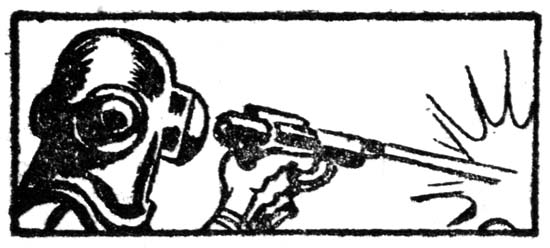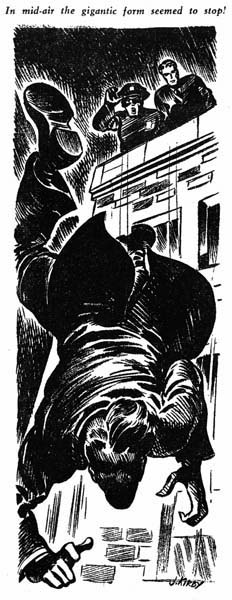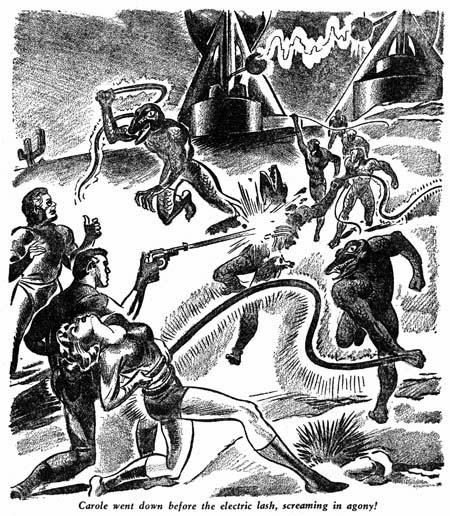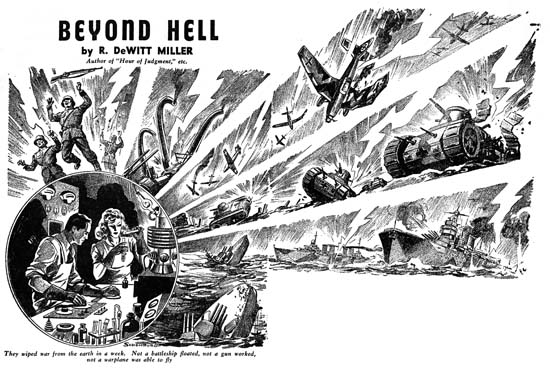Before their were comics there were pulps, and publication of pulps did not end once comics started being produced. The popularity of pulps must have continued since Martin Goodman issued a new pulp title Uncanny Stories with an April 1941 cover date. Pulps were printed and distributed by the same means as comics. I also believe they had the same sales arrangement whereas newsstands would tear off the titles to books that they did not sell and return them for credit. That would suggest that pulps had cover dates that were about two months later then their actual release date. If correct, this means that you should be able to compare cover dates of comics and pulps. So although Uncanny Stories would come out one month after the first issue of Captain America, it was probably being put together while Captain America #1 was still at the printers. Simon and Kirby as a team had not yet had their big hit. Joe Simon had some success to his name with Blue Bolt, a comic feature that the publisher liked so much they launched a new title for it. Joe was also savvy at how to promote himself and had become Timely’s first art director. Jack Kirby, on the other hand, had little success with the work he had done in comics books prior to Captain America. As Goodman’s only art director, it is not surprising that Simon was called upon to have illustrations produced for the pulp stories. Kirby may not yet have had a big hit, but Joe was well aware of his talent. So it is not unexpected that Joe would have many of the illustrations in the first issue of Uncanny Stories drawn by Jack.
Many pulp illustrations were done on stipple board. Stipple boards have a special surface composed of many small irregularly shaped bumps. Normally penciled illustrations did not reproduced well in publications, intermediate pencil tones would be lost unless they were screened, a process that added expense to production. Penciling on stipple board resulted in translation of tones into small dots. The harder the pencil is pressed, the larger the dots become. With stipple boards the screening of pencil drawings could be skipped without loosing quality. The use of stipple boards in pulps gives us the rare opportunity to see the pencils of comic book artists whose work normally would be inked over.

Uncanny Stories v1 n1 (April 1941) Jack Kirby illustration for “Coming of the Giant Germs” by Ray Cummings
larger image
Could this crimson blob, then, huge as a man, be one of the Things that must come when the Comet was in the northern sky? Was this then the murderous phantom that Bob Dean must see consume his own lovely fiancee, to hold her forever there in the heavens where Bob might know her only through a giant telescope?
Jack loved science fiction but I suspect he was a little uncomfortable with illustrating this pulp story. So he transformed the “crimson blob” of the tale into these Pilsbury dough boys. The dough boys may not be as exciting as most of Kirby’s creations, but they are better then a bunch of amorphous blobs. The drawing shows the dough boys flying up with their captives. They do so in such numbers that they actually form the tail of the comet that is in the sky, a rather nice touch. I am sure some other artist would have presented more alluring victims but Kirby does a nice job on the men’s futile struggle to prevent the mass abductions.
Pulps are basically made from a stack of printed papers stapled along one edge. Unlike comic books they have no center fold so double page drawings such as this one are made with gap down the middle. Generally the originally drawing was just split into the two pieces but in this case something was lost. Note how the shoulder of the man in the center just terminates and he is missing his right arm. A thin strip was somehow left out from the center. I have positioned the two pieces so that the gap represents the approximate size the missing piece.

Uncanny Stories v1 n1 (April 1941) Jack Kirby illustration for “Coming of the Giant Germs” by Ray Cummings
Jack also provided a small insert in the story. I doubt that it really is meant to illustrate anything in the novella. It shows nothing more then a helmeted man firing a ray gun, we cannot even see what it is the ray is striking. It truly is a small drawing and could easily be missed as Kirby’s work were it not for the hand. No stipple board this time, just brush and ink.

Uncanny Stories v1 n1 (April 1941) Jack Kirby illustration for “Man from the Wrong Time-Track” by Denis Plimmer
Not all illustrations that Kirby did for this issue of Uncanny Stories are worthy of mention. But there is this one from “Man from the Wrong Time-Track”, a very dramatic drawing of a man plummeting from a building. The man’s face is almost completely in shadows so it is hard to judge what his reaction is to his situation. The caption does not help either, “In mid-air the gigantic form seemed to stop”. Of course pulp illustrations are not really meant to help with the story, but rather to entice a viewer to buy the magazine to find out what it is all about. Jack must have been very satisfied with this illustrations, it is a rare example of a pulp with his signature.

Uncanny Stories v1 n1 (April 1941) Joe Simon illustration for “The Earth-Stealers” by Frederic Arnold Kummer, Jr.
As Timely’s art editor, Joe Simon would generally turn to other artists to provide pulp illustrations but he would on occasion produce one himself. Joe was familiar with working on stipple boards from his previous work as a newspaper artist. Perhaps that is why Joe provides more of a tonal range then Kirby normally did. This illustrations has all the right components; a damsel in distress, weird aliens, frightful weapons (electric lashes), and a mysterious machine (in the background). Nonetheless Joe does not quite pull it off and this pulp illustration is not one of his better efforts.

Uncanny Stories v1 n1 (April 1941) Alex Schomburg illustration for “Beyond Hell” by R. DeWitt Miller
larger image
For “Beyond Hell” Simon turned to another talented artist working for Timely, Alex Schromburg. Alex was a natural for pulp illustration. As a comic book artist, cover illustrations was all Schromburg ever did, as far as I know he never drew a story. As an illustrator Alex had a well deserved reputation, particularly for producing complicated comic covers. This emphasis on complexity can be seen in Alex’s drawing for “Beyond Hell”. I have rejoined the two pieces of art by eliminating the gutter. The joint is not perfect and unfortunately combining the pieces only calls attention to how tilted the background art was. However that does not detract from the spectacle that the scientist has unleashed. German soldiers, big guns, airplanes, tanks and fighting ships all fall to the force of science. For many Americans at that time, this must have seemed what was needed to save them from being pulled into the wars that currently enveloped the world. In reality science was never as good at creating the implements of peace as it was of developing the weapons of war.
Joe and Jack had been working for Timely for a little over a half a year before working on Uncanny Stories or more significantly on Captain America. Captain America changed everything for Joe and more importantly Jack. After the first few issues of Captain America, Jack would end up drawing all the Cap stories. This along with penciling the Vision for Marvel Mystery Comics would keep Jack quite busy. Too busy to continue his pulp illustrator career.

